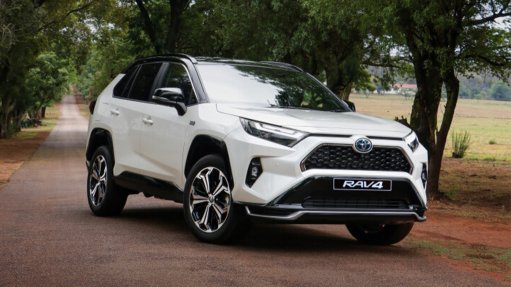
The RAV4 plug-in hybrid
Following the introduction of the RAV4 GX hybrid last year and the RAV4 hybrid E-Four this year, Toyota South Africa Motors (TSAM) says it will test the local market’s response to the RAV4 plug-in hybrid vehicle (PHEV).
While not officially on sale yet, several RAV4 PHEVs have been imported as a market research exercise to test customer response, vehicle behaviour, infrastructure requirements and other technical aspects, as well as to educate customers on plug-in technology.
The purpose of the pilot programme is to allow TSAM to provide its customers “with a holistic and tested solution”, says the local arm of the Japanese vehicle manufacturer.
This also represents Phase 2 of TSAM's new-energy vehicle roll-out plan, following on from the hybrid vehicle expansion strategy executed across Toyota's mainstream product ranges.
Toyota says it RAV4 PHEV “offers the power and clean efficiency of an electric vehicle (EV), without the associated range anxiety or charging dependency”.
“Here you get all the benefits of a traditional full-hybrid vehicle – self-charging, petrol engine back-up and extended range – with the additional performance and pure EV driving mode of a battery electric vehicle (BEV).”
The PHEV RAV4 has a 2.5 l petrol powerplant paired with a larger EV battery and two electric motors, driving each of the axles.
The battery is lithium-ion and supplies 18.1 kW of power. It is located below the passenger compartment.
The petrol engine punches out 136 kW of power and 227 Nm of torque.
The engine is paired with front and rear electric motors which contribute 134 kW and 40 kW, respectively. An additional 270 Nm and 121 Nm of torque is on tap. The resulting total system output is 225 kW.
The plug-in model uses the same architecture as the conventional E-Four model, delivering all-wheel-drive performance by providing electric drive to the front and rear axles.
The petrol engine drives the front axle via a CVT transmission.
The RAV4 PHEV offers the driver four modes to choose from.
EV mode is the default setting and prioritises electric-only operation. The vehicle offers a range of up to 80 km in pure EV mode.
HV mode allows the vehicle to operate like a traditional Toyota hybrid. While the driver can select HV mode as they require, the system will also automatically switch to HV mode should the battery drop below EV-mode operation levels.
This allows the RAV4 to continue on its journey even when the battery has been depleted by using regenerative braking and/or charging the battery via the petrol engine.
Using the HV mode, the RAV4 PHEV extends its driving range to more than 800 km, depending on driven conditions.
The auto EV/HV mode allows the system to switch between pure electric and hybrid modes, based on acceleration input required.
The petrol motor is brought online when required, and then returned to electric operation as soon as conditions permit.
Charging mode is provided to recharge the battery, in which case the system uses the petrol engine to recharge the battery pack.
This is useful for when a recharging facility is not immediately available. Once the hybrid battery is fully recharged, the system will switch to HV mode.
In order to recharge the vehicle conventionally, two solutions are provided, namely a Toyota Mode 2 and Mode 3 charging cable.
Mode 2 allows for home or office charging via conventional AC electric outlets.
The average home charge will take between seven and nine hours.
Mode 3 permits fast DC charging via dedicated charging stations, reducing charging time to 2.5 hours when using a 32A, 6.6 kW charger.